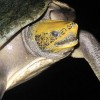 Belize, a country rich in natural resources and diverse wildlife, is home to nine species of freshwater turtles. Among these is the critically endangered hicatee, which has been eliminated in most of its range as a result of hunting and habitat loss. Freshwater turtles live in rivers, creeks, and lagoons, and build their nests on the banks. They eat a variety of plants, aquatic vegetation, and fruits. However, little is known about Belize’s unique turtle species. This 2-page fact sheet will help people identify, understand, and conserve these treasured resources. Written by Venetia Briggs, Lauren Watine, Dustin Smith, Robin Bijlani, Rebecca Harvey, William Giuliano, and Frank Mazzotti, and published by the UF Department of Wildlife Ecology and Conservation, January 2013.
Belize, a country rich in natural resources and diverse wildlife, is home to nine species of freshwater turtles. Among these is the critically endangered hicatee, which has been eliminated in most of its range as a result of hunting and habitat loss. Freshwater turtles live in rivers, creeks, and lagoons, and build their nests on the banks. They eat a variety of plants, aquatic vegetation, and fruits. However, little is known about Belize’s unique turtle species. This 2-page fact sheet will help people identify, understand, and conserve these treasured resources. Written by Venetia Briggs, Lauren Watine, Dustin Smith, Robin Bijlani, Rebecca Harvey, William Giuliano, and Frank Mazzotti, and published by the UF Department of Wildlife Ecology and Conservation, January 2013.
http://edis.ifas.ufl.edu/uw373
Tag: Wildlife Ecology and Conservation Department
Tips for Integrating Land and Wildlife Management: Deer in Forests (WEC329/UW374)
 Prized by hunters and wildlife enthusiasts alike, white-tailed deer are a popular species found throughout Florida. As such, they are often the focus of management for landowners, managers, and lessees who want to improve deer populations while maintaining other land uses such as timber production. This 2-page fact sheet provides some deer habitat improvement tips that focus primarily on raising the quality of deer forage but that also will help you grow better cover by improving plant diversity and productivity. Written by William M. Giuliano, John M. Olson, and Cailey Thomas, and published by the UF Department of Wildlife Ecology and Conservation, January 2013.
Prized by hunters and wildlife enthusiasts alike, white-tailed deer are a popular species found throughout Florida. As such, they are often the focus of management for landowners, managers, and lessees who want to improve deer populations while maintaining other land uses such as timber production. This 2-page fact sheet provides some deer habitat improvement tips that focus primarily on raising the quality of deer forage but that also will help you grow better cover by improving plant diversity and productivity. Written by William M. Giuliano, John M. Olson, and Cailey Thomas, and published by the UF Department of Wildlife Ecology and Conservation, January 2013.
http://edis.ifas.ufl.edu/uw374
Tips for Integrating Land and Wildlife Management: Quail and Timber (WEC331/UW376)
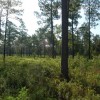 In Florida, changes in forest management practices during the past 50+ years have led to declines in quail habitat and populations. Important changes involve the use of fire and conversion of native forests to commercial pine plantations. A lack of fire and other disturbance has often led to closed-canopy forests with dense undergrowth that lack important quail habitat components. This 2-page fact sheet provides several quail habitat improvement tips that focus on diversifying the plant species and structural composition and increasing early successional communities dominated by herbaceous plants. Written by William M. Giuliano and Lauren Watine, and published by the UF Department of Wildlife Ecology and Conservation, January 2013.
In Florida, changes in forest management practices during the past 50+ years have led to declines in quail habitat and populations. Important changes involve the use of fire and conversion of native forests to commercial pine plantations. A lack of fire and other disturbance has often led to closed-canopy forests with dense undergrowth that lack important quail habitat components. This 2-page fact sheet provides several quail habitat improvement tips that focus on diversifying the plant species and structural composition and increasing early successional communities dominated by herbaceous plants. Written by William M. Giuliano and Lauren Watine, and published by the UF Department of Wildlife Ecology and Conservation, January 2013.
http://edis.ifas.ufl.edu/uw376
Native Pitcherplants of Florida (WEC333/UW378)
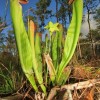 Pitcherplants are perennial plants with groups of leaves modified into traps or pitchers. They have tubular leaves with lids or hoods at the top that secrete nectar to attract prey. Once insects are on the lip of the pitcher, they can slip on the waxy opening and fall into the plant. This 5-page fact sheet provides descriptions of the ranges, appearance, and flowering of the six pitcherplant species native to Florida. Written by Megan E. Brown and Debbie L. Miller, and published by the UF Department of Wildlife Ecology and Conservation, January 2013.
Pitcherplants are perennial plants with groups of leaves modified into traps or pitchers. They have tubular leaves with lids or hoods at the top that secrete nectar to attract prey. Once insects are on the lip of the pitcher, they can slip on the waxy opening and fall into the plant. This 5-page fact sheet provides descriptions of the ranges, appearance, and flowering of the six pitcherplant species native to Florida. Written by Megan E. Brown and Debbie L. Miller, and published by the UF Department of Wildlife Ecology and Conservation, January 2013.
http://edis.ifas.ufl.edu/uw378
Tips for Integrating Land and Wildlife Management: Quail in Cattle Country (WEC332/UW377)
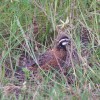 This 2-page fact sheet provides specific tips to improve quail habitat in cattle country that focus on diversifying the plant species and structural composition and increasing early successional communities dominated by herbaceous plants. Written by William M. Giuliano and Lauren Watine, and published by the UF Department of Wildlife Ecology and Conservation, January 2013.
This 2-page fact sheet provides specific tips to improve quail habitat in cattle country that focus on diversifying the plant species and structural composition and increasing early successional communities dominated by herbaceous plants. Written by William M. Giuliano and Lauren Watine, and published by the UF Department of Wildlife Ecology and Conservation, January 2013.
http://edis.ifas.ufl.edu/uw377
How to Use Deterrents to Stop Damage Caused by Nuisance Wildlife in Your Yard (WEC326/UW371)
 Many of us try to attract particular types of wildlife to our yards so that we can observe them. We often select plants and other materials that we know provide food, cover, and water for those animals we like to watch. However, when unwanted wildlife visit your yard and cause damage, you might need to consider the use of tactics that could deter these unwanted species. This 8-page fact sheet was written by Holly K. Ober and Arlo Kane, and published by the UF Department of Wildlife Ecology and Conservation, October 2012.
Many of us try to attract particular types of wildlife to our yards so that we can observe them. We often select plants and other materials that we know provide food, cover, and water for those animals we like to watch. However, when unwanted wildlife visit your yard and cause damage, you might need to consider the use of tactics that could deter these unwanted species. This 8-page fact sheet was written by Holly K. Ober and Arlo Kane, and published by the UF Department of Wildlife Ecology and Conservation, October 2012.
http://edis.ifas.ufl.edu/uw371
How To Identify the Wildlife Species Responsible for Damage in Your Yard (WEC324/UW369)
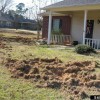 Although many homeowners enjoy wildlife in their yards, there are situations where wildlife can become a nuisance. In some circumstances, wild animals can cause extensive damage to lawns and gardens. Learning to identify which species is responsible for this damage is the first step in finding a solution to the problem. This 6-page fact sheet provides images of wildlife damage in residential settings to help you determine which species may be causing similar problems in your yard. Written by Holly K. Ober and Arlo Kane, and published by the UF Department of Wildlife Ecology and Conservation, October 2012.
Although many homeowners enjoy wildlife in their yards, there are situations where wildlife can become a nuisance. In some circumstances, wild animals can cause extensive damage to lawns and gardens. Learning to identify which species is responsible for this damage is the first step in finding a solution to the problem. This 6-page fact sheet provides images of wildlife damage in residential settings to help you determine which species may be causing similar problems in your yard. Written by Holly K. Ober and Arlo Kane, and published by the UF Department of Wildlife Ecology and Conservation, October 2012.
http://edis.ifas.ufl.edu/uw369
Overview of How to Stop Damage Caused by Nuisance Wildlife in Your Yard (WEC323/UW368)
 In Florida, we are fortunate to have a wide variety of wildlife to watch and enjoy. Indeed, many homeowners attempt to attract particular types of wildlife to their yards to watch. However, wild animals can become a nuisance in some situations. This 4-page fact sheet is the first in a five-part series describing tactics you can use to cope with wildlife that have become a nuisance. Here we suggest a sequence of steps you can implement when wildlife are causing damage in your yard. These suggestions should help reduce wildlife damage in a practical, humane, and environmentally responsible manner. Written by Holly K. Ober and Arlo Kane, and published by the UF Department of Wildlife Ecology and Conservation, October 2012.
In Florida, we are fortunate to have a wide variety of wildlife to watch and enjoy. Indeed, many homeowners attempt to attract particular types of wildlife to their yards to watch. However, wild animals can become a nuisance in some situations. This 4-page fact sheet is the first in a five-part series describing tactics you can use to cope with wildlife that have become a nuisance. Here we suggest a sequence of steps you can implement when wildlife are causing damage in your yard. These suggestions should help reduce wildlife damage in a practical, humane, and environmentally responsible manner. Written by Holly K. Ober and Arlo Kane, and published by the UF Department of Wildlife Ecology and Conservation, October 2012.
http://edis.ifas.ufl.edu/uw368
How to Modify Habitat to Discourage Nuisance Wildlife in Your Yard (WEC325/UW370)
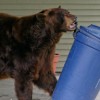 Although often overlooked, habitat modification is the cheapest and most effective long-term solution to nuisance wildlife problems in residential landscapes. Removing the resources wildlife are seeking when they visit your yard can be a much more cost-effective solution than restricting access to those resources with physical barriers, scaring wildlife with hazing tactics, deterring wildlife with repellents, or removing wildlife by trapping or killing nuisance animals. This 3-page fact sheet was written by Holly K. Ober and Arlo Kane, and published by the UF Department of Wildlife Ecology and Conservation, October 2012.
Although often overlooked, habitat modification is the cheapest and most effective long-term solution to nuisance wildlife problems in residential landscapes. Removing the resources wildlife are seeking when they visit your yard can be a much more cost-effective solution than restricting access to those resources with physical barriers, scaring wildlife with hazing tactics, deterring wildlife with repellents, or removing wildlife by trapping or killing nuisance animals. This 3-page fact sheet was written by Holly K. Ober and Arlo Kane, and published by the UF Department of Wildlife Ecology and Conservation, October 2012.
http://edis.ifas.ufl.edu/uw370
How to Use Traps to Catch Nuisance Wildlife in Your Yard (WEC327/UW372)
 When wildlife become a nuisance in your yard, there are three general approaches you can take: make habitat modifications, use deterrents, or trap animals. In most residential settings, making habitat modifications or using deterrents will be both simpler and more effective than trapping. But trapping is warranted in certain situations when trying to solve conflicts between people and wildlife. This 6-page fact sheet provides information on stopping wildlife damage through the use of trapping. Written by Holly K. Ober and Arlo Kane, and published by the UF Department of Wildlife Ecology and Conservation, October 2012.
When wildlife become a nuisance in your yard, there are three general approaches you can take: make habitat modifications, use deterrents, or trap animals. In most residential settings, making habitat modifications or using deterrents will be both simpler and more effective than trapping. But trapping is warranted in certain situations when trying to solve conflicts between people and wildlife. This 6-page fact sheet provides information on stopping wildlife damage through the use of trapping. Written by Holly K. Ober and Arlo Kane, and published by the UF Department of Wildlife Ecology and Conservation, October 2012.
http://edis.ifas.ufl.edu/uw372
Conservation Subdivision: Post-construction Phase – Urban Trees Can Reduce Household Carbon Footprint (WEC321/UW366)
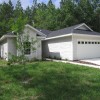 During the post-construction phase, the conservation and planting of native trees in individual yards and open spaces can reduce household and neighborhood carbon footprints. This 5-page fact sheet discusses the importance of urban trees and their role in mitigating for climate change by avoiding carbon emissions and removing carbon dioxide from the atmosphere. Written by Richard Vaughn, Mark Hostetler, and Francisco Escobedo, and published by the UF Department of Wildlife Ecology and Conservation, June 2012.
During the post-construction phase, the conservation and planting of native trees in individual yards and open spaces can reduce household and neighborhood carbon footprints. This 5-page fact sheet discusses the importance of urban trees and their role in mitigating for climate change by avoiding carbon emissions and removing carbon dioxide from the atmosphere. Written by Richard Vaughn, Mark Hostetler, and Francisco Escobedo, and published by the UF Department of Wildlife Ecology and Conservation, June 2012.
http://edis.ifas.ufl.edu/uw366
Florida’s Seepage Slope Wetlands (WEC322/UW367)
 Florida is home to one of North America’s most unique and diverse ecosystems, the seepage slope. Unusual hydrology and frequent fires combine to create an environment that supports a variety of carnivorous and other sun-loving herbaceous plants. This 5-page fact sheet discusses the natural history and conservation concerns associated with seepage slope wetlands. Written by Megan E. Brown and Debbie L. Miller, and published by the UF Department of Wildlife Ecology and Conservation, June 2012.
Florida is home to one of North America’s most unique and diverse ecosystems, the seepage slope. Unusual hydrology and frequent fires combine to create an environment that supports a variety of carnivorous and other sun-loving herbaceous plants. This 5-page fact sheet discusses the natural history and conservation concerns associated with seepage slope wetlands. Written by Megan E. Brown and Debbie L. Miller, and published by the UF Department of Wildlife Ecology and Conservation, June 2012.
http://edis.ifas.ufl.edu/uw367
The Invasion of Exotic Reptiles and Amphibians in Florida (WEC320/UW365)
 Florida has more introduced species of reptiles and amphibians living and breeding in the wild than anywhere else in the world. This 6-page fact sheet summarizes findings from three recent scientific papers describing who these invaders are, their potential ecological impacts, and recommendations for their management and control. Written by Frank J. Mazzotti and Rebecca G. Harvey, and published by the UF Department of Wildlife Ecology and Conservation, May 2012.
Florida has more introduced species of reptiles and amphibians living and breeding in the wild than anywhere else in the world. This 6-page fact sheet summarizes findings from three recent scientific papers describing who these invaders are, their potential ecological impacts, and recommendations for their management and control. Written by Frank J. Mazzotti and Rebecca G. Harvey, and published by the UF Department of Wildlife Ecology and Conservation, May 2012.
http://edis.ifas.ufl.edu/uw365
Laws that Protect Florida’s Wildlife (WEC48/UW076)
 Endangered species are not the only wildlife protected by the legal system. All of Florida’s wildlife is more or less safeguarded by a variety of laws. Laws addressing wildlife can be found at the federal, state, regional, and local levels of government. Wildlife protection may also take the form of conventions, treaties, and executive orders. All are subject to periodic change. For example, legislators can alter or delete laws every year. This 5-page fact sheet summarizes federal laws and state statutes and rules. Written by Joe Schaefer, John Tucker, and Maia McGuire, and published by the UF Department of Wildlife Ecology and Conservation, February 2012.
Endangered species are not the only wildlife protected by the legal system. All of Florida’s wildlife is more or less safeguarded by a variety of laws. Laws addressing wildlife can be found at the federal, state, regional, and local levels of government. Wildlife protection may also take the form of conventions, treaties, and executive orders. All are subject to periodic change. For example, legislators can alter or delete laws every year. This 5-page fact sheet summarizes federal laws and state statutes and rules. Written by Joe Schaefer, John Tucker, and Maia McGuire, and published by the UF Department of Wildlife Ecology and Conservation, February 2012.
http://edis.ifas.ufl.edu/uw076
Conservation Subdivision: Construction Phase: Low Impact Development (LID) and Stormwater Treatment (WEC319/UW364)
 Because so much area in subdivisions is covered by impervious surfaces such as roads, buildings, and driveways, stormwater runoff must be accounted for and treated to prevent flooding and to remove contaminates. Often, stormwater runoff impacts surrounding landscapes and water bodies due to nutrient loading. In this 7-page fact sheet, we discuss the importance of using a more distributed stormwater treatment system that treats runoff closer to the source. Often called Low Impact Development (LID), this stormwater management approach is being used to more effectively remove pollutants from runoff. Written by Daniel Penniman, Mark Hostetler, and Glenn Acomb, and published by the UF Department of Wildlife Ecology and Conservation, March 2012.
Because so much area in subdivisions is covered by impervious surfaces such as roads, buildings, and driveways, stormwater runoff must be accounted for and treated to prevent flooding and to remove contaminates. Often, stormwater runoff impacts surrounding landscapes and water bodies due to nutrient loading. In this 7-page fact sheet, we discuss the importance of using a more distributed stormwater treatment system that treats runoff closer to the source. Often called Low Impact Development (LID), this stormwater management approach is being used to more effectively remove pollutants from runoff. Written by Daniel Penniman, Mark Hostetler, and Glenn Acomb, and published by the UF Department of Wildlife Ecology and Conservation, March 2012.
http://edis.ifas.ufl.edu/uw364
Climate Change Adaptation: New Perspectives for Natural Resource Management and Conservation (WEC318/UW363)
Climate change is creating new challenges for conservation and management of natural resources. As temperatures, rainfall patterns, and disturbance regimes change and sea levels rise, ecosystems are being transformed. With climate change species and communities may move out of the fixed systems in reserves that were established to protect them, and may not have the needed migration corridors to successfully disperse. The rate at which climate is projected to change in coming decades is likely too fast for many species to genetically adapt or to migrate to new suitable areas. Climate change underscores the need to transform our view of the natural world. While many of our conservation tools and approaches will stay the same, a new perspective will enable us to better apply these tools to meet future challenges. This 3-page fact sheet summarizes recommendations from four recent reviews of the literature on climate change adaptation. Written by Rebecca G. Harvey, Laura A. Brandt, and Frank J. Mazzotti, and published by the UF Department of Wildlife Ecology and Conservation, February 2012.
http://edis.ifas.ufl.edu/uw363
Northern Racoon (WEC34/UW033)
Raccoons are found statewide in Florida in ever-increasing numbers. Urbanization and agriculture often help their population because food becomes more available in these conditions. Therefore, it is not at all uncommon to encounter raccoons near your home or neighborhood. Learn more facts about raccoon biology and how to (legally) solve raccoon problems. This 7-page fact sheet was written by William H. Kern Jr., and published by the UF Department of Wildlife Ecology and Conservation, January 2012. http://edis.ifas.ufl.edu/uw033
Wildflowers Susceptible to Deer Damage in North Florida (WEC315/UW360)
 One sure way to prevent deer damage to your landscape is to choose plants that deer do not like to eat. Unfortunately deer foraging preferences vary geographically and studies conducted with captive deer aren’t always accurate. So UF/IFAS wildlife researchers investigated the foraging preference of wild white-tailed deer at two sites in Gadsden County with high deer densities for two years. Of 11 wildlfowers tested, four were very susceptible to browsing: fringeleaf tickseed, Florida tickseed, coastalplain tickseed, and orange coneflower. This 4-page fact sheet was written by Holly K. Ober, Lucas W. DeGroote, James H. Aldrich, Jefferey G. Norcini, and Gary W. Knox , and published by the UF Department of Wildlife Ecology and Conservation, December 2011.
One sure way to prevent deer damage to your landscape is to choose plants that deer do not like to eat. Unfortunately deer foraging preferences vary geographically and studies conducted with captive deer aren’t always accurate. So UF/IFAS wildlife researchers investigated the foraging preference of wild white-tailed deer at two sites in Gadsden County with high deer densities for two years. Of 11 wildlfowers tested, four were very susceptible to browsing: fringeleaf tickseed, Florida tickseed, coastalplain tickseed, and orange coneflower. This 4-page fact sheet was written by Holly K. Ober, Lucas W. DeGroote, James H. Aldrich, Jefferey G. Norcini, and Gary W. Knox , and published by the UF Department of Wildlife Ecology and Conservation, December 2011.
http://edis.ifas.ufl.edu/uw360
Baiting the Nine-banded Armadillo (WEC317/UW362)
 What is the tastiest treat to tempt an armadillo? Armadillos are one of the most significant nuisance pests in Florida and much of the Southeast. There are no repellents, toxicants, or fumigants registered for use with them. They are good at both burrowing beneath and climbing over fences. There are also no effective methods for baiting them into traps. So the authors of this 3-page fact sheet set up a test to determine which materials have the greatest potential to serve as bait. Written by Holly K. Ober, Lucas W. DeGroote, and Russell F. Mizell III, and published by the UF Department of Wildlife Ecology and Conservation, December 2011.
What is the tastiest treat to tempt an armadillo? Armadillos are one of the most significant nuisance pests in Florida and much of the Southeast. There are no repellents, toxicants, or fumigants registered for use with them. They are good at both burrowing beneath and climbing over fences. There are also no effective methods for baiting them into traps. So the authors of this 3-page fact sheet set up a test to determine which materials have the greatest potential to serve as bait. Written by Holly K. Ober, Lucas W. DeGroote, and Russell F. Mizell III, and published by the UF Department of Wildlife Ecology and Conservation, December 2011.
http://edis.ifas.ufl.edu/uw362
Una Guía para Convivir con Felinos Silvestres (WEC316/UW361)
 En Belice, el Centro de Investigaciones de Campo Lamanai (CICL) y la Universidad de la Florida están estudiando los gatos usando trampas-cámaras las cuales se han colocado dentro de varios locales de terrenos privados. Contrario a lo que la gente considera, esta investigación sugiere que existe una mayor cantidad de felinos silvestres habitando cerca de las fincas. This 3-page informational brochure is the Spanish language version of A Guide to Living with Wildcats (WEC314/UW359). It highlights 5 species of wildcats living in the area of the study, tips for keeping livestock safe, and local contacts. Written by Venetia S. Briggs, Rebecca G. Harvey, Frank J. Mazzotti, and William M. Giuliano, and published by the UF Department of Wildlife Ecology and Conservation, October 2011.
En Belice, el Centro de Investigaciones de Campo Lamanai (CICL) y la Universidad de la Florida están estudiando los gatos usando trampas-cámaras las cuales se han colocado dentro de varios locales de terrenos privados. Contrario a lo que la gente considera, esta investigación sugiere que existe una mayor cantidad de felinos silvestres habitando cerca de las fincas. This 3-page informational brochure is the Spanish language version of A Guide to Living with Wildcats (WEC314/UW359). It highlights 5 species of wildcats living in the area of the study, tips for keeping livestock safe, and local contacts. Written by Venetia S. Briggs, Rebecca G. Harvey, Frank J. Mazzotti, and William M. Giuliano, and published by the UF Department of Wildlife Ecology and Conservation, October 2011.
http://edis.ifas.ufl.edu/uw361